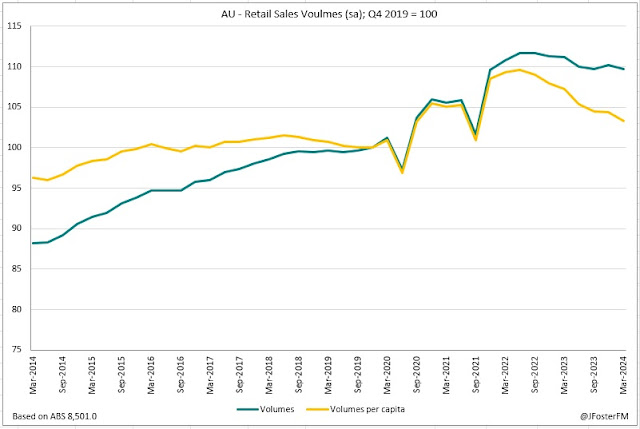Following a temporary boost from the Black Friday sales ahead of Christmas, weakness in Australian retail volumes returned falling by 0.4% in the March quarter. The ABS reported this was the 5th decline for retail volumes in the past 6 quarters, with cost-of-living pressures and higher interest rates seeing households cutting back, particularly on discretionary-related purchases.
Retail volumes (retail sales adjusted for inflation) fell by 0.4% for the 3 months to March. The weakest outcomes were in household goods (-2.9%) and department stores (-0.4%), driving an overall decline of 0.7% across the discretionary categories. However, volumes increased in clothing and footwear (1.3%), cafes and restaurants (0.3%) and 'other' retailing (0.5%). Food volumes were flat in the quarter.
Over the past year, retail volumes have decreased substantially by 1.3%. This is partly inflated by the post-pandemic rotation to services spending, while new vehicle sales - not a component of the retail data - have also been very strong; however, household demand has unequivocally pulled back in the retail sector as the headwinds from the higher cost of living and RBA rate hikes have impacted. Weaker demand (as well as improvements on the supply side) has seen retail price growth slow materially to a pace around 2.5% in year-ended terms from 6% a year ago. Because prices have kept rising (albeit at a slowing pace), retail spending in nominal terms increased over the past year (1.2%) - despite the large contraction in underlying demand.
The weakness in retail volumes is especially notable as it has come alongside rapid population growth driven by post-pandemic inward migration. Adjusting for the population increase, retail volumes are even weaker on a per capita basis, falling for the 7th quarter in a row in Q1 (-1%). This leaves per capita volumes just 3.3% above their pre-pandemic level at the end of 2019, compared to a 9.7% increase in headline volumes over the period.





